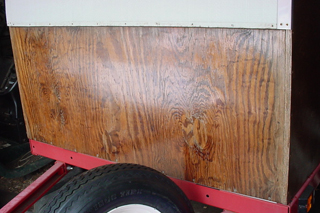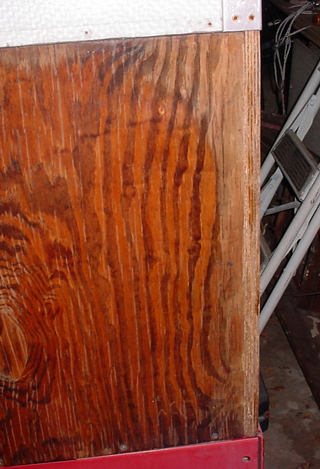
I have a question on refinishing a project I recently did. I built a 4′ x 8′ teardrop trailer and I used Minwax Red Oak as a stain and Minwax Helmsman Spar urethane over the stain. I thought I had all the trim strips sealed with silicone sealer but evidentally I missed one strip and found I had water damage to one corner of the front panel. I also had another spot inside that was damaged. I know I probably ought to do the job by stripping the whole area and starting over, but is there a way to correct the damaged area without stripping the whole surface and starting over? My biggest concern is getting the stain to match if I strip just the damaged area. I have attached two pictures, one showing the whole area and one showing the water damage. — Jim Sholtis
Chris Marshall: The upside to spar varnish is its flexibility when cured, which helps it stand up to the elements on outdoor projects. But, like any finish that’s exposed to sunlight and moisture, it’s not a cure-all solution. I doubt you’d be able to strip just a portion of that damaged area without lightening the stain in the process outside the repair area, so the repair would look obvious…and probably bad. There would also be the issue of new finish bonding poorly to old finish around the edges of the repair, which would likely breach the waterproofing aspect of your finish all over again. Photos only show so much, but it appears that the spar varnish is cracking vertically in other places on that panel as well, and the water damage is extending from the right corner around to the top. I’d be inclined to strip the whole panel and start over. I’d also store the trailer out of sunlight when not using it and wipe it dry when it gets wet.
Tim Inman: Minwax Red Oak stain is an interior product, so performance outdoors or under sunlight and wet/dry conditions is questionable at best. I really doubt you will have long-term satisfaction from this. I’m seeing in the pictures you sent along what appears to be a possibility of a bigger issue. Sometimes stains react with things in the wood, and it changes their colors. Was the wood washed or sealed or cleaned with something prior to staining that might have left behind a stronger acid or basic surface? It looks like I can see marks left behind by a wiping action. The extreme red that I’m seeing looks more to me like an acid reaction than would be expected. Also, the word “silicone” just gives any finisher the heebie-jeebies. Silicone and finishes are NOT friends. I’m afraid I don’t have any good news or better alternatives for you on this one.






